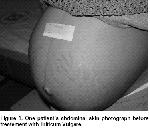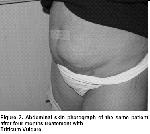Stria is a fairly common symptom
7. It was first reported in 1889 in the medical literature histologically and defined by Unna in 1894 and by Gans and Steigleder in 1925 (2,75). Developmental stages of stria can be clinically observed. Initially it has a pinkish violaceous color on skin level and is pruritic
1,3,5. Violaceous stria gets wider and longer by time, its color fades and turns white, and the lesion depresses
2,3. It may have a mildly wrinkly surface. A mature stria characteristically has an irregular shape, its long axes are parallel to skin stretching lines and it has an atrophic appearance; therefore, it is believed that striae are caused by damage in dermal collagen and elastic fibers
3,5.
It generally develops in healthy adult women due to puberty or pregnancy. It is seen on the abdomen and breast in 90% of pregnant women 4,8. It can also be observed in case of mechanical stretching of the skin as in rapid weight gain 8,9. Stria is formed by destruction of collagen and elastin in the dermis 4. Burg claimed in 1976 that stria was a form of scar and was reversible 7. Irrespective of its cause, recovery process of stria does not resemble that of a scar, after stria is formed 4.
Stria is a cosmetic problem. An efficient treatment for stria could not be developed yet and number of studies on this topic is fairly limited. Kang S et. al. used 0.1% topical tretinoin in the treatment of early stage stria and showed an apparent recovery 1. In a similar study with a larger series, they once again found that 0.1% tretinoin brought about clinical recovery in stria 6. Elson ML. treated 20 patients with different stages of stria and established a marked recovery in 15 out of 16 patients who completed the study 2. As opposed to these 3 studies, Pribanish S. et. al. applied 0.025% tretinoin to 32 patients with abdominal stria and stated that it was not effective 4. In the previous studies, striae were treated at any stage and it was noted that tretinoin was effective in both early and late striae. However, we and Elson claimed that stria could recede only when it was pinkish violaceous in color and was not depressed, in other words in the early period only 1. Triticum Vulgare is a scattering and re-epithelizing agent. It stimulates leukocyte migration and invasion in afflicted skin. It activates fibroblast synthesis and fibroblast movement towards the area of lesion. It increases the activation of inisitol phospholipid hydrolysis and ornithine decarboxylase, known as the growth factor. It also gives the skin elasticity by increasing the synthesis of glycosaminoglycan and decarboxylase, which are collagen fibers that have an important part in scar recovery 10.
There is no study about the treatment of stria with Triticum Vulgare. In the present study we applied Triticum Vulgare to 11 patients who had stria associated with pregnancy. We found complete recovery in 45.4%, marked recovery in 36.3% and recovery in 18.1% of patients treated with Triticum Vulgare. We used Triticum Vulgare in early period of stria, which poses a serious cosmetic problem, and found it highly effective. In consideration of the fact that it can also be used during pregnancy, we think Triticum Vulgare can be highly beneficial. We think that studies with larger series are needed on this topic.





